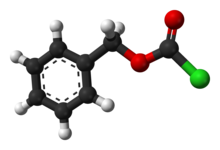Benzyl chloroformate

| |

| |
| Names | |
|---|---|
| IUPAC names
Benzyloxycarbonyl chloride
Benzyl chloroformate | |
| Other names
Z-Chloride
| |
| Identifiers | |
3D model (JSmol)
|
|
| ChemSpider | |
| ECHA InfoCard | 100.007.205 |
PubChem CID
|
|
CompTox Dashboard (EPA)
|
|
| |
| |
| Properties | |
| C8H7ClO2 | |
| Molar mass | 170.59 g·mol−1 |
| Density | 1.195 g/cm3 |
| Boiling point | 103 °C (217 °F; 376 K) (20 Torr) |
| Hazards | |
| Flash point | 80 °C (176 °F; 353 K) |
| Safety data sheet (SDS) | External MSDS |
Except where otherwise noted, data are given for materials in their standard state (at 25 °C [77 °F], 100 kPa).
| |
Benzyl chloroformate is the benzyl ester of chloroformic acid. It is also known as benzyl chlorocarbonate and is an oily liquid whose color is anywhere from yellow to colorless. It is also known for its pungent odor. When heated, benzyl chloroformate decomposes into phosgene and if it comes in contact with water it produces toxic, corrosive fumes.
Preparation
It is prepared in the lab by dropping benzyl alcohol into liquid phosgene at −20 °C. Phosgene is used in excess to minimise the production of the carbonate.[1]
Uses
Benzyl chloroformate is used in organic synthesis for the introduction of the carboxybenzyl (abbreviated Cbz or Z) protecting group for amines:
The newly formed Cbz protecting group can be removed under reductive conditions. Typically hydrogen gas and activated palladium on carbon are used.
References
- ^ Hough, L.; Priddle, J. E. (1961). "Carbonate derivatives of methyl α-D-mannopyranoside and of D-mannose". J. Chem. Soc. 1961: 3178–3181. doi:10.1039/JR9610003178.
External links

